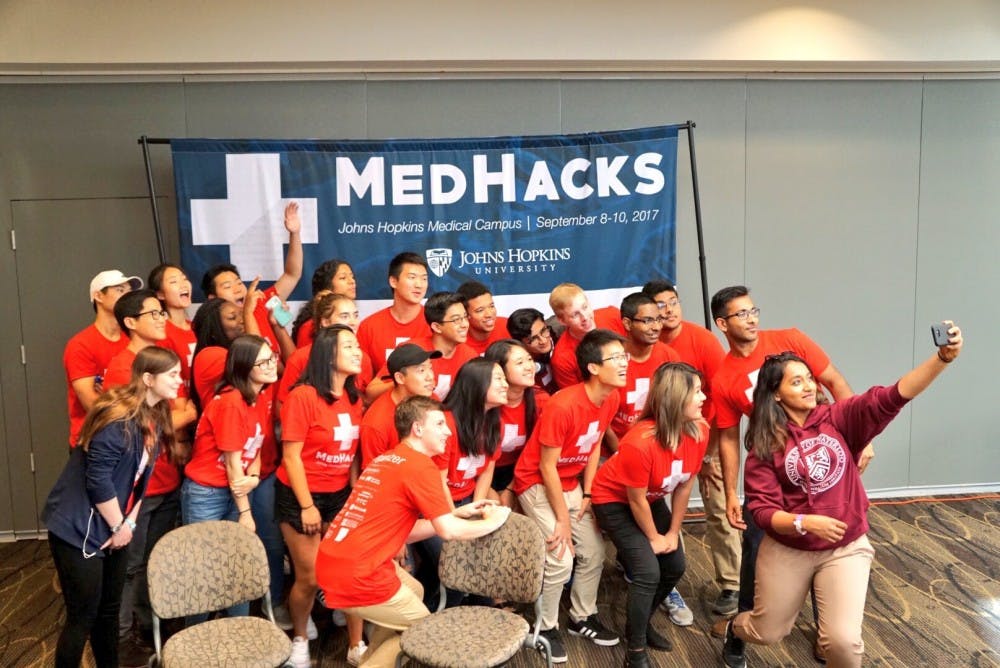Hundreds of students gathered for MedHacks, a student-organized medical hackathon, which was held from Sept. 8-10 on the med campus.
Gearing up for the annual event, MedHacks Co-directors Suraj Shah and Patrick Myers shared their visions for this year’s slightly revised version of the hackathon.
Shah, currently a junior majoring in biomedical engineering and minoring in computer science and entrepreneurship, said that MedHacks recieved a record number of apllications from all across the nation this year.
“Specifically, many of the applicants came from east coast institutions such as MIT and Rutgers,” Shah said. “MedHacks also surprisingly received a significant number of applications from Canada.”
Myers, a junior majoring in biomedical engineering and minoring in both computational medicine and computer integrated surgery, added that this is the third year that Hopkins has hosted the annual event.
MedHacks was originally started by two Hopkins alumni who graduated this past spring. Over the years the MedHacks team introduced new ideas and changes to help grow the hackathon.
This year the event took place in the Turner Auditorium, which is part of the Ross Research Building at the med campus. Previously, MedHacks was held in the Bloomberg Center for Physics and Astronomy on Homewood Campus. Both Myers and Shah are excited that this year the event took place at a larger venue.
In total MedHacks received more than 2,700 applications. There were 600 hackers who attended the event, half of which were Hopkins affiliated students and staff.
Kathy Hu, the co-lead of promotion for the event, first joined MedHacks because she thought it was a good blend of technology and medicine. She had never taken part in a hackathon prior to joining MedHacks, but thought it would be a great experience given the role technology plays in medical innovation.
For Hu, the best part of MedHacks was seeing how motivated and invested all the participants were in the problems facing healthcare today.
“It’s so cool to witness people all over the world come together and spend 36 straight hours working hard with little sleep, united by their passion for solving health related issues,” she said.
A typical schedule for the MedHacks weekend looked something like this: After the opening ceremony, a pitching session was held. Participants proposed healthcare problems they were interested in working on, and they were given time to form teams and work together.
After 36 hours of hacking and developing solutions, everyone met up on Sunday morning. That was when judges from sponsoring companies, renowned researchers and physicians, all came together to discuss and eventually declare winners for the first three places.
In essence, MedHacks is different from a traditional hackathon because its projects focus on medical solutions. It is an “ideathon” rather than a hackathon, where hackers don’t necessarily need to code or come up with a tangible app.
The main goal of MedHacks is to work in teams with medical professionals, researchers and industry managers in order to devise solutions to ongoing medical issues.
This year there were three title sponsors for three broad medical tracks: accessibility to care, ensuring patients properly take their meds, and patient safety and quality. Each track was sponsored by a different company or institution, such as the Armstrong Institute at Johns Hopkins Medicine and CVS Pharmacy. Some aspects focused more on improving patient-physician interactions, while other areas revolved around ideas like overprescription.
“My favorite part of MedHacks was being able to get involved in an innovative community with diverse people bringing together different skills and ideas, both on the hacker and mentor levels,” Meyers said. “Students in various majors such as BME, computer science, public health, and philosophy came together for an entire weekend to engage in something they’re really passionate about, and I think that means a lot. Many students were able to make connections that extended beyond the hackathon.”
Jason Li, a sophomore Neuroscience and computer science major reflected on how the stress of the event was actually conducive to learning.
“My team and I were able to finish our project, but man, this has been quite a nerve wrecking weekend. We tried to develop an iOS app, but no one from the team had extensive experience with the software ,” Li said. “80 percent of the time was spent on just learning things. But I think I learned more in the past two days than I would in a week.”
The first place winner was a team that created a smart bed to track a patient’s pressure points and can inflate to prevent sores from forming.
The second place team focused on the spread of microfluidics to areas that struggle with health care. The third place team created an app to test hand tremors for Parkinson’s patients.
The first place team this year received a grant of $1,500 while the second and third place teams received $1,250 and $1,000, respectively.
In order to make it to the end, they had to pass two rounds of selection processes supervised by 30 judges total. Following the hackathon, these winners will still have the opportunity to work with their sponsors to develop their products.





